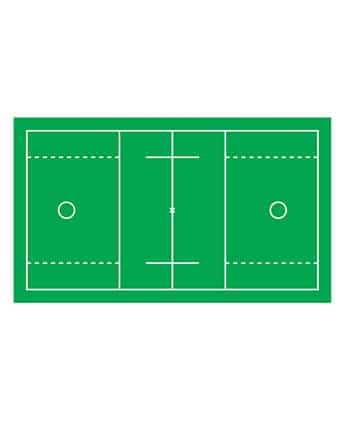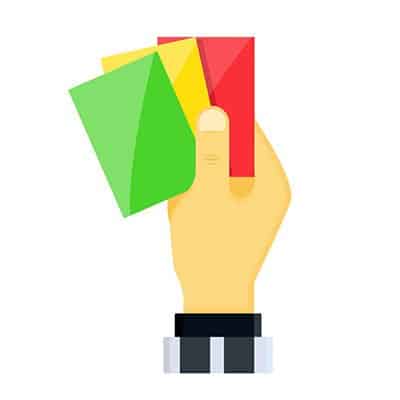Lacrosse is an incredibly fast-paced and intense game—one where understanding the rules, penalties, and benefits can be key. With that in mind, we want to break down what you must know about lacrosse crease violations.
We'll provide some insights into how the rule works, potential penalties for violating it, and more. So let's get started!
More...
Take away key points:
If you're unsure what the crease line is and the rules explaining it, you can refer to the guide below for a better understanding. Let's learn more about the position and possible penalties in the lacrosse game.
What is a lacrosse crease line?

The crease line is a critical part of lacrosse's rules, helping to define goal areas and keep the game 'honest' when players get too close. The crease line is nine feet in diameter and circular in shape, with its center marked at the center of the lacrosse goal.
This area inside the designated circle is considered to be part of the goalie's protected zone, meaning any attacking player who enters must back off once warned by an official. Only the goalie can possess the ball in this zone, and defensive players can enter as long as they don't have possession of it.
Taking this further, if the ball does enter that same area, no player from either team can touch it until it exits the crease line. This way, any interference or one team's advantage over the other team is avoided.
However, if a team is found to commit a crease violation, they will be penalized with a technical foul. Technical foul leads to the thirty-second penalty or a change of possession of the ball.
What are the exceptions to the vulnerable position?
There are specific exceptions to this lacrosse rule, making the referee's decision challenging.
For instance, one such example is when the offensive player's momentum carries them into the area after the lacrosse ball enters the goal.
Another example is when defensive players push the offending player from the other team into the crease, and the offending player scores the goal. In these situations, the goal will count in both men's lacrosse and women's lacrosse, and there won't be any penalties on the lacrosse field.
Furthermore, there is a lacrosse trick known as crease diving. It's controversial in lacrosse, as the crease dive is allowed in professional and collegiate-level lacrosse but not in youth lacrosse and high school game level.
Crease diving is when an offensive player intentionally jumps into the crease area to get a better shooting angle but cannot touch the ground unless the ball enters the net and he scores.
Can an offensive player from the attacking team commit a crease violation?
A crease violation occurs when an offensive player of the attacking team enters the line during a shot attempt. Only the goalie and defenders can enter the crease area as the crease surrounds the goal line and the area around the net.
Since the goalkeeper is the only lacrosse player allowed possession of the ball inside the crease area, once the offensive player of the attacking team enters the line, he commits the goal crease violation. As a result, the referee will blow their whistle and assign the ball possession to the opposing team.
If a ball enters the net and an attacking player scores a goal, the goal will not count. However, the referee will throw a flag if an opposing player violates the line when the defensive player possesses the ball. Thus, during the next dead ball, the offensive player will be charged with the thirty-second penalty.
Does violation count as personal fouls or technical fouls?
The crease violation counts as a technical foul rather than a personal one. Thus, it's less serious than a personal foul but still vital.
Technical fouls will cause the offensive players to violate the rule of the sport. It can result in either a thirty-second penalty charged to the offensive who violated the rules or a change of possession.
Although players will not commit a serious 'crime' during the game, they can jeopardize the overall score and affect the team's chances of winning the games.
The examples of the crease violation
Here are some of the best examples of the crease violation for a better understanding.
- The offense enters inside the crease while trying to dodge from behind the goal and goalie. The offense will shoot and score, but the goal is annulated, and the team loses possession to another team.
- There is a loose ball outside the crease, and a member of the offense falls inside the crease. If a defense does not recover the loose ball, the officials will award the possession to their team upon a team gaining possession.
- A defender tries to clear a ball, and an opposing offending player runs through the crease to stop him. The referee will throw a flag, and the defender will have time to complete their fast break before the referee issues the penalty to the opponents.
How will the referee deal with the trespassed players?

Once the referee notices the violation of the crease, he will blow the whistle and stop the play. Next, he will award the possession to the defensive player and other players on the same team. Then, the play will begin again on their sideline.
If offensive players scored a goal, it would be waived off, and the play would continue. But, if the offensive team scored the goal when the defensive side had the ball possession, the referee would throw a flag. Then, he will award possession of the ball to the other team, change the possession, or assess the thirty-second penalty for the next dead ball.
The signs referees make for the violation of crease in lacrosse
When offensive players score a goal when violating the crease in lacrosse, the referee will wave his hands to "waive off" the goal and point to the crease to signal the violation of the rules.
If a referee throws a flag to signalize the violation of the crease, he will also make a T-sign with his hands to indicate it's a technical foul after the play has stopped. The next step is to charge the offensive player with a thirty-second penalty.
Similar violations to the crease violation
Lacrosse is an incredibly fast-paced and exciting sport - but one of the difficult parts to learn is some of its rules, especially regarding violations. Crease violations are just one of the many rule-breaking opportunities in lacrosse.
Some others that can get players penalized include the following: goalkeeper interference, offside, warding, and holding.
Goalkeeper interference
Goalkeeper interference is when a player outside the crease interferes with the goalkeeper and his ability to defend the goal.
Offside
Offside occurs when either too many players from one team are on the offensive side, or too few are on their respective defensive ends of the field.
Warding
Warding off involves attempting to keep an opposing player away by forming a wall with your stick or intentionally pushing the opponent while in possession of the ball.
Holding
Holding occurs when a player uses physical contact to gain an advantage with or without the ball. For example, one player uses his arm, stick, or feet to prevent the opponent from going to his desired position.
All these violations are punishable and must be avoided during play for proper lacrosse rules to be observed.
FAQs
Who is not allowed in the crease in lacrosse?
Offensive players are forbidden to step into the crease, regardless of whether they have the ball possession.

Can a goalie come out of the crease in lacrosse?
Yes, a goalie can come out of the crease in lacrosse after he/she receives the possession. However, they must step with both feet out of the line to be considered out and need to pass the ball further.
But, once out, the goalie cannot return to the crease with the possession of the ball. Instead, another field player can go to the crease in the place of the goalie if the team has the ball possession.
How long can a lacrosse goalie hold the ball in the crease?
Once a goalie gains the ball, the goalie has four seconds (men's goalies) or ten seconds (women's goalies) to either throw a pass or leave the crease.
Does crease violation rule apply in women's and box lacrosse as well?
Yes, the crease violation rule of the crease violation applies to women's and box lacrosse too.
The attacker cannot be inside the crease while the ball possession is there. The only exception is that the player might be inside the goal line extended area by following the dive or scoring a goal when pushed by the defense.
How big is a girl's lacrosse crease?
The crease in girls' lacrosse is 8.5 feet in diameter.
Final thoughts
A crucial part of playing lacrosse is to be aware of the different types of penalties that can be called on a player.
For example, though a lacrosse crease violation may not seem like a big deal, it results in a thirty-second penalty, or the team loses possession. This can be costly if players are not careful enough while on the field.
Be sure to avoid an unnecessary penalty by understanding all the rules of the game!
